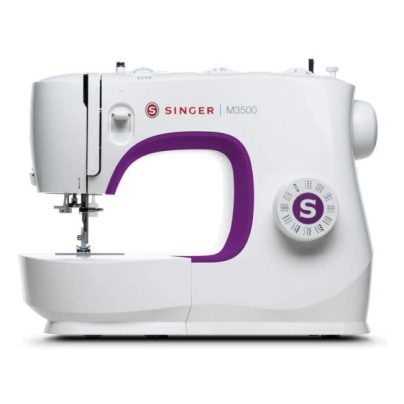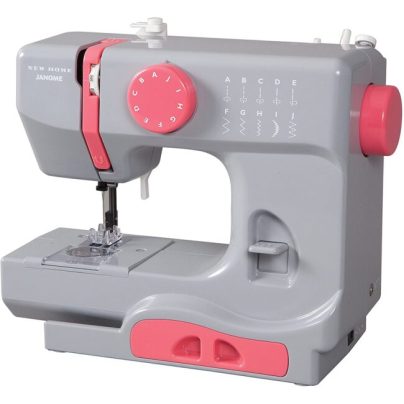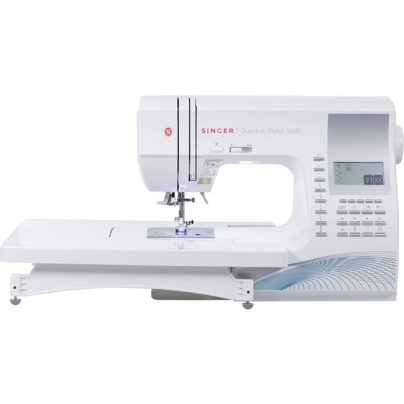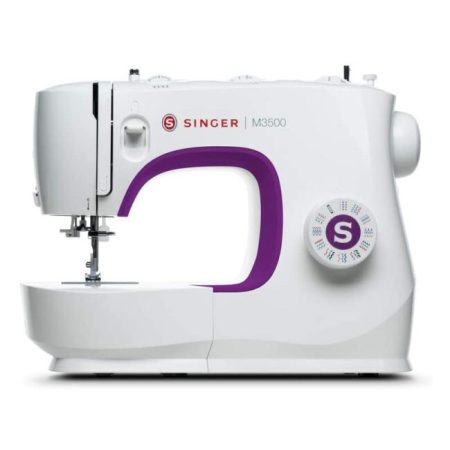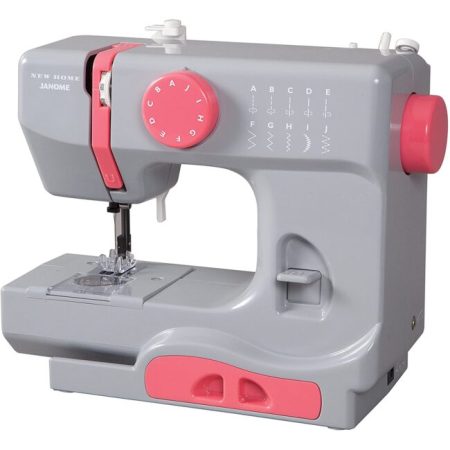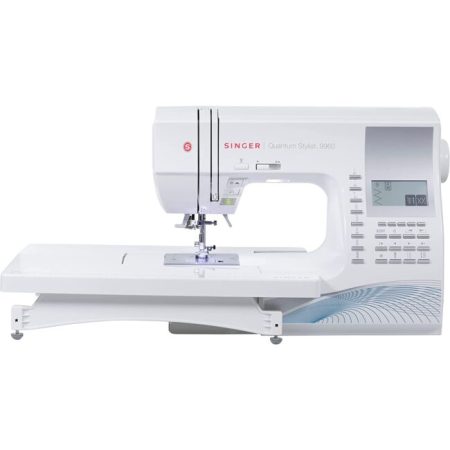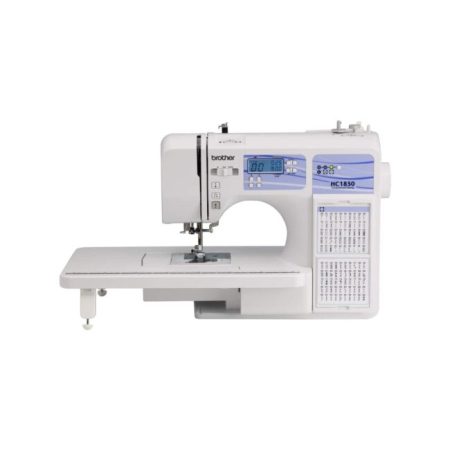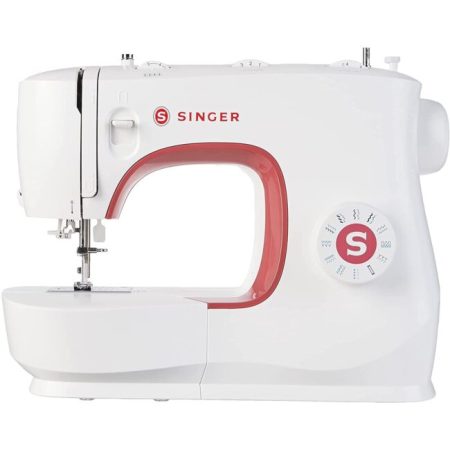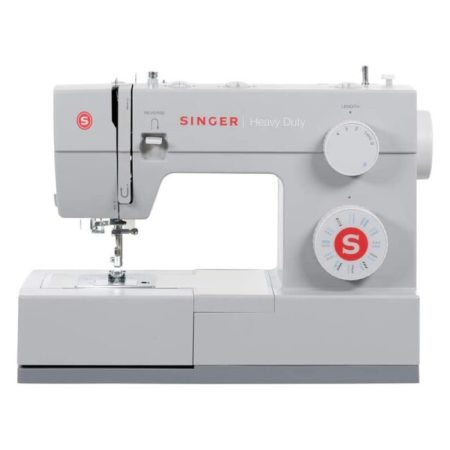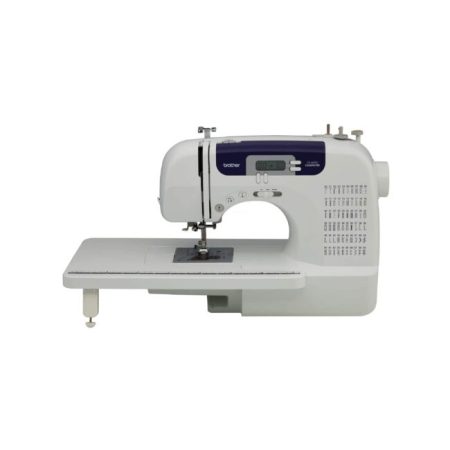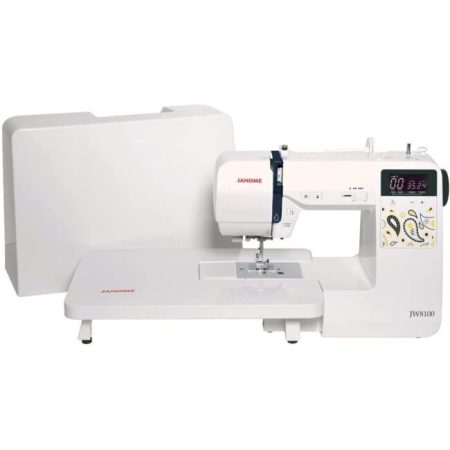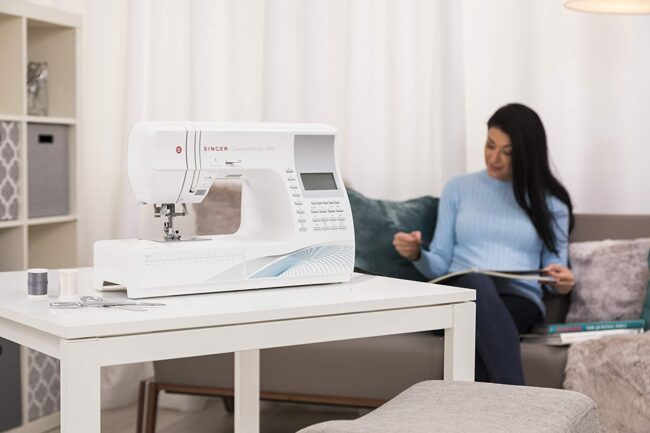
We may earn revenue from the products available on this page and participate in affiliate programs. Learn More ›
We know that sewing machines can look intimidating to novice crafters, but with the right sewing machine for beginners, anyone can learn how to sew. A sewing machine is a useful, creative tool to have at home, allowing crafters to hem and mend garments or household items, or make something entirely new. Read on for our advice on some features you can consider when shopping for a new sewing machine as well as the best sewing machines for beginners.
- BEST OVERALL: Singer M3500 Sewing Machine With Accessory Kit
- BEST BANG FOR THE BUCK: Janome Derby Compact Sewing Machine
- UPGRADE PICK: Singer 9960 Sewing & Quilting Machine
- BEST COMPUTERIZED: Brother HC1850 Sewing and Quilting Machine
- BEST MINI: Singer MX231 Sewing Machine With Accessory Kit
- BEST HEAVY-DUTY: Singer 4423 Heavy Duty Sewing Machine
- BEST FOR QUILTING: Brother Sewing and Quilting Machine, CS6000i
- ALSO CONSIDER: Janome JW8100 Computerized Sewing Machine
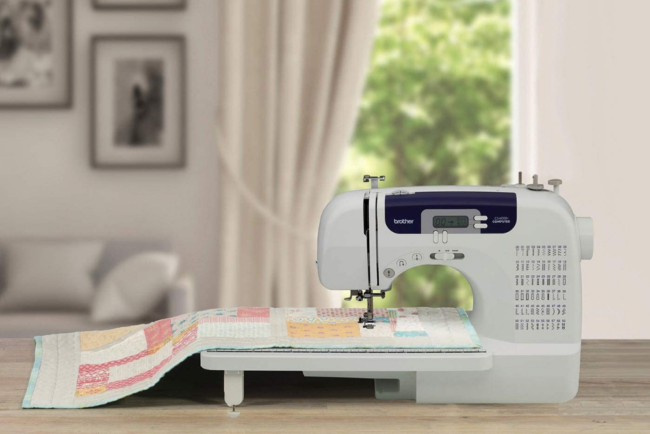
How We Chose the Best Sewing Machines for Beginners
Sewing is a rewarding hobby, but getting started can be overwhelming. The good news is, there are plenty of sewing machines suitable for novice sewists. When evaluating the best starter sewing machine options, we kept ease of use, price, and sewing functions in mind.
Through extensive product research, we found sewing machines that are packed with user-friendly features, as well as backed up with excellent shopper reviews. Features like versatile stitching options, automatic threading, and simple-to-load bobbins were beginner-friendly features we looked for.
Hobby novices usually don’t want to spend an arm and a leg on their craft, so we kept affordability in mind. In addition to affordability, you will want a sewing machine that is reliable enough to serve a range of uses, whether for hemming a sweater or for crafting new curtains. Lastly, to ensure reliability, we chose sewing machines from well-established and trusted brands.
Our Top Picks
With user-friendliness, cost, and versatility in mind, we narrowed down the best sewing machines for beginners. These machines make it easy for you to get set up and start stitching quickly. The novice-friendly sewing machines ahead open the door to a whole new world of creative projects.
Best Overall
Singer M3500 Sewing Machine With Accessory Kit
Product Specs
- Type: Mechanical
- Number of stitches: 32
- Weight: 15 pounds
Pros
- Easy manual controls
- 32 built-in stitches for 110 stitch applications
- One-step buttonhole feature
Cons
- Some beginners may not prefer the front-loading bobbin
Mechanical sewing machines are a popular choice for new sewists because their simpler design makes them easier to learn how to use. The Singer M3500 is an excellent mechanical machine that is easy to use but also goes beyond the basics.
It includes 32 built-in stitches, with the basics that every sewist needs, as well as decorative and stretch stitches. Users can adjust stitch width and length and take advantage of 110 stitch applications that are ideal for beginner projects and beyond.
Other novice-friendly features include an automatic needle threader and an easy one-step buttonhole mode. Learning the controls on this machine is easy with its simple manual dials. To handle bigger projects down the line, this machine has a heavy-duty metal frame for long-lasting durability.
Get the Singer M3500 Sewing Machine With Accessory Kit at Amazon or The Home Depot.
Best Bang For The Buck
Janome Derby Compact Sewing Machine
Product Specs
- Type: Mechanical
- Number of stitches: 10
- Weight: 5 pounds
Pros
- Fun and colorful design
- Drop-in bobbin
- Very lightweight
Cons
- Limited stitch options
Sewing doesn’t need to be an expensive hobby. The Janome Derby compact sewing machine is the best affordable sewing machine for those who want to start sewing on a budget. Although affordable, this sewing machine has all the must-have basic features you’ll need for a solid start in sewing. It features 10 built-in stitches, including multiple essential straight and zigzag stitches, with two needle positions. An easy-reverse lever makes it simple to backstitch at the start and end of each stitch.
Other beginner-friendly features include a drop-in bobbin with a clear cover and clear threading diagrams on the machine. Built-in accessory storage helps users keep track of small pieces. This machine is also impressively lightweight, weighing only 5 pounds, so it’s a great choice to take to sewing classes and craft groups. This machine comes in several colors, and the bright design is fun for adults and children alike.
Get the Janome Derby Compact Sewing Machine at Amazon or The Home Depot.
Upgrade Pick
Singer 9960 Sewing u0026 Quilting Machine
Product Specs
- Type: Computerized
- Number of stitches: 600
- Weight: 18 pounds
Pros
- 600 built-in stitches
- Monogramming feature with 5 font choices
- 13 buttonhole stitches
- Includes an extension table
Cons
- Steeper learning curve to take advantage of all the features
With 600 built-in stitches, the Singer 9960 can handle almost any project a beginner sewist can throw at it, as well as a ton of projects made by experienced crafters. For beginners, this computerized machine features an automatic needle threader, speed controls, and a built-in thread trimmer. A drop-in bobbin with a clear cover case makes it easy to install the bobbin and monitor the thread supply.
Among the 600 fonts are several basic, stretch, and decorative stitches, including five different alphanumeric fonts for monogramming and 13 one-step buttonhole stitches for sewing clothing. Several stitches can be mirrored or elongated for even more creative options. One-touch stitch selection makes it easy to find your intended stitch. This heavy-duty machine can also handle tough fabrics and quilting, and it comes with an extension table for when a larger working area is needed.
Get the Singer 9960 Sewing & Quilting Machine at Amazon.
Best Computerized
Brother HC1850 Sewing and Quilting Machine
Product Specs
- Type: Computerized
- Number of stitches: 185
- Weight: 13 pounds
Pros
- Suitable for quilting
- Monogramming feature
- Wide table
- 185 built-in stitches
Cons
- May be too complicated for some users
Computerized sewing machines offer more features than mechanical versions, and all are controlled with the touch of a button. The Brother HC1850 Sewing and Quilting Machine has several beginner-friendly features, including an automatic needle threader, a drop-in bobbin, and adjustable sewing speed, plus an instructional DVD and access to Brother’s technical support.
For those who want to expand into quilting projects and more, this sewing machine includes a detachable wide table, eight accessory feet, and the ability to do free-motion quilting. With 185 built-in stitches, which includes 55 alphanumeric for monogramming, users should be able to tackle a range of designs.
Even though this machine can handle heavy-duty projects, it’s still lightweight and portable. At 13 pounds, it’s easy to tote around or to pull in and out of storage.
Get the Brother HC1850 Sewing and Quilting Machine at Amazon.
Best Mini
Singer MX231 Sewing Machine With Accessory Kit
Product Specs
- Type: Mechanical
- Number of stitches: 23
- Weight: 12 pounds
Pros
- Lightweight
- Small footprint
- Built-in carrying handle
- Several adjustable settings
Cons
- Some beginner sewists may not like the front-loading bobbin
For those with limited work or storage space, a
is the ideal choice. The Singer MX231 Sewing Machine is a full-featured machine with a relatively small footprint. It’s also reasonably lightweight at 12 pounds. A built-in carry handle makes this machine an excellent choice to take on the road.
Although this machine is small, it doesn’t skimp on beginner-friendly features. It has 23 built-in stitches to tackle a range of projects, including basic stitches, decorative stitches, and a convenient one-step buttonhole stitch. Adjustable stitch length and width settings and an adjustable presser foot help users tailor the machine to their needs.
This machine also features an automatic needle threader. It has a front-loading bobbin, but it is still easy to wind and insert.
Get the Singer MX231 Sewing Machine With Accessory Kit at Amazon.
Best Heavy-Duty
Singer 4423 Heavy Duty Sewing Machine
Product Specs
- Type: Mechanical
- Number of stitches: 23
- Weight: 14.5 pounds
Pros
- Can handle heavy-duty jobs
- Fast 1,100 stitch-per-minute maximum sewing speed
- Sturdy metal frame
Cons
- Relatively loud operation
A heavy-duty sewing machine can easily handle heavy fabrics and tough projects. The Singer 4423 Heavy Duty Sewing Machine is an excellent choice for beginners who want to tackle big projects. This sewing machine has a sturdy metal interior frame and a powerful motor to zoom through thick fabrics like denim, leather, canvas, and multilayered projects. A fast maximum sewing speed of 1,100 stitches per minute allows users to finish their projects quickly.
Both beginners and experienced sewists can take advantage of the automatic needle threader, easy-to-follow threading guide, the one-step buttonhole stitch, and the drop-in bobbin with a clear cover. Even though it’s a heavy-duty workhorse, this sewing machine still isn’t too heavy at 14.5 pounds, and a built-in handle makes it even easier to move around.
Get the Singer 4423 Heavy Duty Sewing Machine at Amazon.
Best For Quilting
Brother Sewing and Quilting Machine, CS6000i
Product Specs
- Type: Computerized
- Number of stitches: 60
- Weight: 13 pounds
Pros
- Detachable wide table
- Can handle large projects
- Bright LED lighting
Cons
- Limited speed control with foot pedal
Beginner quilters will find the Brother CS6000i Sewing and Quilting Machine is packed with novice-friendly features, all at a reasonable price. This computerized sewing and quilting machine has an automatic needle threader, a drop-in jam-resistant bobbin, variable speed settings, and an easy-to-use backlit display. Users can choose from 60 stitches, including seven one-step buttonhole stitches, which are useful for a range of sewing and quilting projects.
Quilting can take up a lot of space, so this sewing machine includes a detachable wide table for sewing quilts as well as large garments and costumes. LED lighting provides a brightly lit sewing area so users can easily see their project’s every detail.
Get the Brother CS6000i Sewing and Quilting Machine at Walmart.
Also Consider
Janome JW8100 Computerized Sewing Machine
Product Specs
- Type: Computerized
- Number of stitches: 100
- Weight: 12 pounds
Pros
- Great for both beginner and experienced sewists
- Start/stop button to sew without using the foot pedal
- Includes extension table
Cons
- Pricey
The Janome JW8100 Sewing Machine is another full-featured choice for new sewists who hope to expand their skills. This computerized machine has several novice-friendly features, including a drop-in bobbin, a speed control slider, and an automatic needle threader.
With 100 stitch options (including seven buttonhole stitches) and an included extension table for larger projects, sewists can continue using this machine as their skills grow. This computerized machine chooses optimal stitch length and width settings for each stitch, but users can also override this feature to customize projects.
Besides its stitch options, this machine includes several convenient buttons, including two that are particularly beginner-friendly: a start/stop button allows users to sew without using the foot control, and an easy-reverse button makes it simple to backstitch and lock seams.
Get the Janome JW8100 Computerized Sewing Machine at Amazon.
Jump to Our Top Picks
What to Consider When Choosing a Sewing Machine for Beginners
Sewing machines can seem complicated, especially to a beginner. New fabric artists should look for a sewing machine that is easy to use but with enough features to tackle a range of projects. Ahead are some factors to consider when choosing the best beginner sewing machine.
Types of Sewing Machines
There are various product types for shoppers to consider, and the best sewing machine for home use depends on the crafter’s sewing requirements. Some common sewing machine types include:
- Mechanical: Modern mechanical sewing machines run on electricity, and their settings are adjusted with dials or switches on the machine. Mechanical sewing machines tend to be the best beginner sewing machine option because they are less complex and more affordable.
- Computerized: Instead of knobs and dials, computerized sewing machines have a built-in computer system to control their settings and automated features.
- Serger: Also known as an overlock sewing machine, a serger isa specialty sewing machine. As the fabric moves through the machine, sergers hem, seam, and finish the edges with an overlock stitch to keep them from fraying. Sergers have at least three thread sources to create this stitch.
- Coverstitch: Coverstitch machines are used to create professional finished hems. Unlike sergers, they do not trim the fabric.
- Embroidery: Embroidery machines are another specialized machine used to embroider programmed designs onto fabric rather than to stitch fabric together. Combination sewing and embroidery machines are also available.
Size and Weight
Sewing machines come in a range of sizes, from compact options made for travel to larger machines that can take on thicker materials and heavy-duty projects. A sewing machine should be used on a sturdy table (and with a comfortable chair), so consider the size of your work space when choosing a machine. Also decide if the sewing machine will be a permanent fixture, or if you’ll want a smaller, more lightweight machine that is easy to stow away when not in use.
Another feature to consider is portability. Lightweight and battery-operated sewing machines are available for those who want to take it on the road to sewing classes or hobby groups, or for those with limited space. However, smaller machines tend to sacrifice some functionality for their compact size.
Also consider the size of your projects. It can be difficult to maneuver large swaths of fabric through a tiny machine. For quilting, look for a sewing machine with expandable arms. Keep in mind that while expandable arms make quilting much easier, they are heavy and take up more space.
Project and Fabric Type
When choosing a sewing machine, you’ll want to consider not only the projects you want to do, but also the fabrics you plan to work with.
For smaller projects, or items made with thinner fabrics like cotton and polyester, most standard sewing machines will suffice. Larger and heavy-duty sewing machines are better for heavier fabrics, like denim, velvet, and upholstery fabrics, or for heavier projects like making coats, jeans, and home decor, like drapes. For quilting, look for a machine that can sew through thick layers and with a larger work space or an extension table.
Those interested in more decorative projects should consider a machine with decorative stitches and the option for free-motion stitching. Combination sewing and embroidery machines are a good choice for decorative designs and can be programmed to embroider decorations instead of free-handing patterns.
Number of Built-In Stitches
It can take several stitch types to pull a piece together, and you’ll want your sewing machine to be able to handle the stitches you need. Most sewing machines allow for some stitch adjustments, although some of the more basic models may only offer a straight stitch. Even as a beginner, it’s a good idea to look for a machine with various built-in stitches so the machine can keep up with your projects as you learn.
Stitch options can range from a few basic stitches to more than 100 stitch options. Consider the stitches you will likely use; for beginner projects, this can include common stitches like a straight stitch, a reverse stitch, a zigzag stitch, a buttonhole stitch, and stretch stitches. Many sewing machines also have the option to change stitch length, width, and tension.
Self-Threading Capacity
Regardless of the sewing machine, one of the first steps to get it running is to thread the machine. Getting the thread through the small needle eye can be challenging, especially for beginners. Even for experienced sewing machine users, threading the needle can be tough, especially for those with poor eyesight or hand dexterity.
Fortunately, many sewing machines have automatic threaders that make the job easier. These mechanisms, usually located right next to the needle, save time and hassle by threading the needle for you with a user-friendly built-in mechanism, usually consisting of a couple of small levers and hooks.
Additional User-Friendly Features
Sewing machines can include a range of additional beginner-friendly features, including:
- Automatic thread cutter: Rather than reaching for scissors when you need to snip your thread, a built-in thread cutter takes care of the job on its own.
- Speed control: Learning how to control the foot pedal can be a bit of a learning curve. Speed control options allow users to set machine speed settings to their comfort level.
- Drop-in bobbin: This small feature can be worthwhile for beginners, as it allows the user to drop the bobbin into the top of the machine without fiddling around. See-through bobbin cases also make it easier to monitor the bobbin.
- Presser feet: Different types of feet can be used for different projects. Some machines include a variety of presser feet, which can include a buttonhole foot and a button sewing foot.
- Built-in work lights: Having a well-lit sewing area is key for the user to keep track of stitching. A built-in work light makes things that much simpler.
FAQs
Learning how to sew is a fun and useful pastime, and with a sewing machine, you can create even more intricate creations. Choosing the right sewing machine can feel daunting, since the options and features feel endless. If you’re still deciding on the best home sewing machine for your needs, consider the frequently asked questions and answers ahead.
Q. How much should a beginner spend on a sewing machine?
There are several excellent beginner-friendly sewing machine options under $200. Spend what feels comfortable for your budget.
Q. Can I teach myself to use a sewing machine?
Absolutely—by following the instructions in the manual (and using online tutorials, when needed), anyone can teach themselves to sew using one of the best starter sewing machine options.
Q. Is sewing an expensive hobby?
It depends on the type of sewing machine and fabrics you choose to work with. There are some up-front costs to get started, but sewing doesn’t need to be an expensive hobby.
Q. Is sewing difficult to learn?
Getting started isn’t difficult; it’s easy to learn how to use one of the best basic sewing machine options. Mastering sewing is much more difficult, but practice makes perfect.
Q. What should I learn to sew first?
To get more accustomed to the machine, use a simple pattern for your first project. Some easy first-time sewing projects include making a napkin, a pillowcase, a tote bag, a headband, or an apron.
Q. What are the basic tools needed for sewing?
Many sewing machines will come with the basic tools to use the machine. Other tools you should have on hand include thread spools in your chosen thread colors, sewing scissors, pins, a measuring tape, an iron and ironing board, and a seam ripper in case of any mistakes.
Q. What is the most important method you need to remember in sewing?
When learning how to sew with a sewing machine, one of the most important methods to master is the straight stitch, a foundational stitch for many sewing projects.
Why Trust Bob Vila
Bob Vila has been America’s Handyman since 1979. As the host of beloved and groundbreaking TV series including “This Old House” and “Bob Vila’s Home Again,” he popularized and became synonymous with “do-it-yourself” home improvement.
Over the course of his decades-long career, Bob Vila has helped millions of people build, renovate, repair, and live better each day—a tradition that continues today with expert yet accessible home advice. The Bob Vila team distills need-to-know information into project tutorials, maintenance guides, tool 101s, and more. These home and garden experts then thoroughly research, vet, and recommend products that support homeowners, renters, DIYers, and professionals in their to-do lists.
